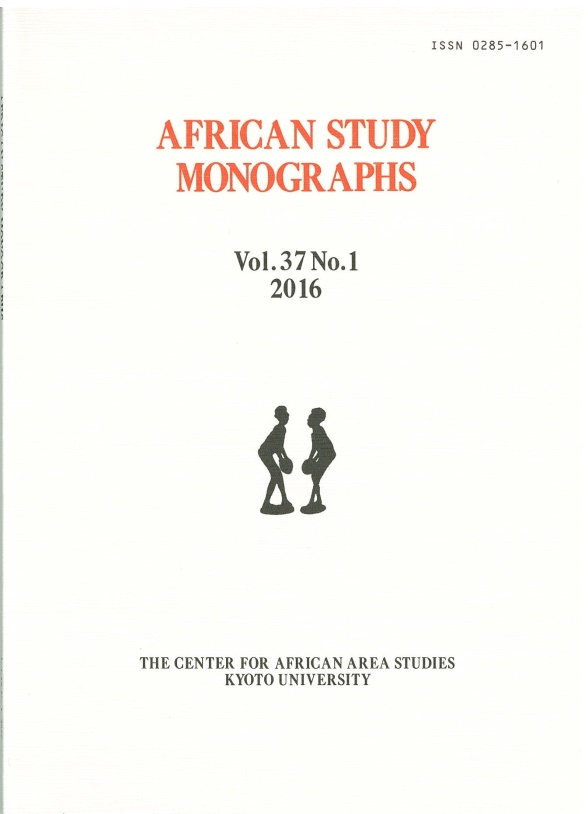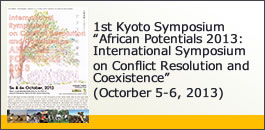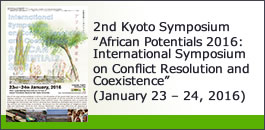Date: September 23, 2011
Venue: Inamori Foundation Memorial Bldg. (Inamori Center), Middle-sized Meeting Room (Room No. 332), Kyoto University
Program
11:00-12:00 Miwa Tsuda (Institute of Developing Economies)
From Mediation to International Criminal Court: Coping with PEV in Kenya
12:00-12:30 Motoji Matsuda (Kyoto University)
Tasks and Problems of the Truth, Justice and Reconciliation Commission in Kenya
12:30-13:00 Naoki Naito (National Museum of Ethnology)
Confrontation of Local Groups Caused by General Election and its Local Solutions: A Case of the Pastoral Ariaal in Northern Kenya
13:00-14:30
Discussion
Report Overview
Three speakers presented talks that focused on the Post-Election Violence (PEV) in Kenya from 2007 to 2008 and the subsequent conflict-resolution processes.
Miwa Tsuda (Institute of Developing Economies)
From Mediation to International Criminal Court: Coping with PEV in Kenya
Miwa Tsuda first addressed the damage caused by the hostilities and the circumstances that led to the eruption of PEV. She then spoke about the setbacks in the post-conflict reconciliation process in Kenya that ended with the involvement of the International Criminal Court (ICC). The Waki Commission’s October 2008 report had advised for a special tribunal for the PEV within the nation; however, a lack of majority support in the parliament resulted in failure to establish the tribunal. A year later, in October 2009, President Kibaki and Prime Minister Odinga announced their intentions to entrust the ICC with the prosecution of the PEV perpetrators named by the Waki Commission. In December 2010, the ICC opened two cases of “crimes against humanity” during the PEV, naming six individuals implicated in the cases. In March 2011, summonses were issued for these people. Currently, the first phase of judicial proceedings is being held in the Pre-Trial Chamber of the ICC, and it is being debated whether sufficient evidence exists for each criminal charge against the accused. During the inquiry, it has been argued that Kenyan support for the ICC comes mainly from the urban intellectual class, while the majority of Kenyans see the six subpoenaed individuals as “martyrs, sacrificed to Western European colonial power.”
Motoji Matsuda (Kyoto University)
Tasks and Problems of the Truth, Justice and Reconciliation Commission in Kenya
The following speaker, Motoji Matsuda, explained the process for establishing the Truth, Justice and Reconciliation Commission (TJRC) in Kenya, and current developments surrounding it. The commission was ratified in April 2008 and began its activities in August 2009 on the basis of the principles of “national healing and reconciliation.” However, the commission was not active. In April 2011, local hearings finally began in various regions of the country. The commission is exploring how to use the model of South Africa’s post-apartheid Truth and Reconciliation Commission’s dialogue-based reparative justice. Criticism of the commission, however, focuses on the possibility that the dialogues will be used as political tools to delay the punishment for the perpetrators named in the Waki Report. Furthermore, it has been pointed out that there is no political legitimacy for a truth commission to be established by the current president’s administration, which has held sway at the center of Kenya’s politics since independence. It has been also noted that the period of history at issue only begins from national independence in 1963, ignoring discussion of the grave human-rights violations that occurred prior to the period when Kenya was under the control of the British colonial government. During the question-and-answer session, participants discussed the average Kenyan citizen’s views about and expectations from the commission and how these expectations were strikingly low. It was also mentioned that newspaper articles on the subject are rare. Moreover, when such articles do appear, news of the ICC is printed on the political news pages, while that of the commission is relegated to general or miscellaneous columns. The question was raised as to why, in the case of not only Kenya but also other countries, Western nations frequently have high expectations for initiatives such as truth commissions, whereas the citizens of the country in question do not particularly pay much attention to them.
Naoki Naito (National Museum of Ethnology)
Confrontation of Local Groups Caused by General Election and its Local Solutions: A Case of the Pastoral Ariaal in Northern Kenya
The third presenter was Naoki Naito, who spoke about the Ariaal people of northern Kenya and how deeply hostile relations developed between them and their neighbors on the occasion of the national parliamentary elections. Naito also discussed the extent to which these hostilities receded after the elections. In 2003, the Constituency Development Fund was introduced in Kenya, allowing members of parliament to freely use part of funding distributed to their electoral districts. As a result, local interest in elections rose. Over an electoral zone, a candidate from the Ariaal society labeled the Rendille people (who up to that time had been known as kinsmen by the Ariaal) as enemies. This deepened divisions between the social groups. However, after the elections, rather than speaking about the differences that were created and intensified during the elections, people chose to conceal them in order to prevent any further deterioration of relations. Naito emphasized that this stance of “muting” themselves functioned to avoid any exacerbation of the enmity. During the question-and-answer session, the issue came up of whether irreversible changes had occurred between the daily life before the elections and the restored daily life after the heightened animosity between the social groups.
Discussion
Initially, during the overall group discussion, the talk centered on how to relate the ICC stance of calling for “punishment through impartial laws” and the “African approach” to conflict resolution when dealing with PEV in Kenya.
First, it was noted that there is domestic criticism within Kenya of the practice of “punishment through impartial laws” that was attempted by the ICC. However, the criticism is partly driven by politicians who seek the continuation of the political impunity they enjoy. The speakers noted that there is considerable danger of them being seen as aligning with such a viewpoint in the lack of careful management of their anthropological argument, which is that “rather than imposing Western norms of universal justice, avenues should be explored to address the current state of affairs by leveraging African Potentials.”
Furthermore, the participants voiced their thoughts on the debate over the assertion by international society that “the ICC should pass judgment according to the global standards of law because if matters are left to Africa, punishment will only be avoided.” The discussion brought up a host of points: (1) Matters must proceed on the basis of the fundamental principle that judgment in some form must be passed on those who transgressed. (2) The Kenyan government should take some blame for the involvement of the ICC because it was they who failed to establish the special tribunal. (3) There is a strong possibility that neglecting punishment will re-manifest a long-term trend of “skirting the blame.” However if outside agencies participate in passing judgment and punishment, then the long-term impact should also be considered, such as a backlash of nationalism in the country concerned. (4) The international law is heading toward a direction where it should not expound the form of universal justice that simply overlooks a regional context but rather continue to consider the framework of public opinion in each country that it judges. (5) Even for the ICC—the steward of “impartial law”— while decision making is being carried out by recourse to laws, extralegal factors warrant real consideration as well in the process of judging the perpetrators.
In addition, assertions were made that the people of Africa do not overreact to the mediation by the ICC and this is a typical “African” response. Further, while handling the perpetrators, all participants—the ICC, state, and local communities—rely upon basic standards that are established by the international society, mainly of the West. However, a majority of African societies generally have a more diluted approach to disciplining “criminals.” As such, the discussion noted that it may be necessary to shift the boundary between “grave violations” and problematic behaviors.
Discussion then focused (not solely in the case of Kenya but other African nations as well) on whether more general “African Potentials” can be effective in reconciling and controlling large-scale organizational violence during and after conflict. It was pointed out that, first of all, because “African Potentials” have been downplayed till now, it is necessary to start considering them as a means to address and suppress conflict. At the same time, however, there certainly are limitations to the capacity of these potentials, and therefore it is necessary to study the problems they can and cannot resolve. In connection with this issue, it was mentioned that there exist “points of no return” in tremendously escalated violence (such as in Rwanda’s 1959 social revolution hostilities) that make it extremely difficult to suppress conflicts emerging from very large-scale organized unrest. Conversely, it was also noted that before reaching such points, “African Potentials” should be leveraged so that the possibility of turning back still exists in the background. Last, it was stated that despite the continued prevalence of violence in various African societies, it is important to clarify and illuminate the characteristics of those societies that have been relatively successful at stemming conflict at an early stage. (Reporter: Toru Sagawa)


 Exploring African Potentials, Mila Special Issue
Exploring African Potentials, Mila Special Issue
